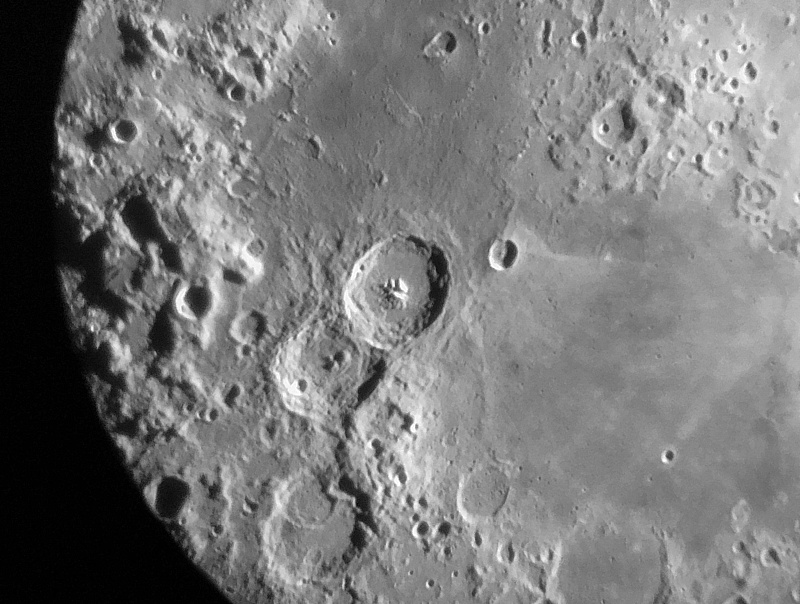Critter; Crater Theophilus, Jupiter Eupora & Io Shadows
Posted: 15 March 2016
Sunday, 13 March 2016, was clear until late afternoon when clouds appeared from the Northwest and the wind began blowing. I had hoped to open the observatory anyway to do some lunar observing and imaging at the very least, but as sunset approached the sky was mostly cloudy. Since I didn't go to the observatory I was able to get these photographs of a Harris's Hawk about sunset:


Monday was partly cloudy and windy during the day.
|
Open: Monday, 14 March 2016, 1815 MST Temperature: 78°F |
Session: 934 Conditions: Mostly clear, breezy |
Upon opening the observatory I prepped the D7200 DSLR for lunar imaging. 1833 MST: sunset. Powered on the 12" LX600; turned StarLock OFF (remained off for entire session). 1836 MST: viewed the Moon, 102X. Switched to the 2" 9mm (271X) eyepiece for some lunar observing. Unlike the previous sessions, seeing was pretty good at this point in the evening. There were many nice sights on the Moon, especially Crater Theophilus. Switched to a 1.25" 5.5mm (443X) eyepiece. Wow, super views! Took this handheld iPhone 6s Plus afocal 443X image (slightly cropped) of Crater Theophilus:

I then added the Optec focal reducer and did some White Balance tests on the Moon: Auto vs Day (5200K). It turned out that Auto was the best for the Moon. This is a (full-frame) image of the Moon, D7200 DSLR, 1/320sec, ISO 400, White Balance Auto:

Removed the focal reducer and used eyepiece projection (9mm, 271X) using the OPT Camera Adapter for this (cropped) image of Theophilus, 1/250sec, ISO 3200, WB Auto:

1920 MST: resumed lunar observing, 443X. Seeing was getting a little worse now. Switched back to 271X.
1932 MST: went to Jupiter, low in the east, and viewed it at 271X. The moons Europa and Io were in transit, but were not visible (planet too low in the sky). However, their shadows were visible. The shadows were transiting along the North Equatorial Belt. 1954 MST: seeing at Jupiter was getting worse, instead of better. A large cloud was approaching Jupiter from the south. 2004 MST: cloud began dissipating. 2010 MST: seeing at Jupiter a little better now. Decided to try some DSLR imaging of Jupiter even though seeing was not ideal.
Used eyepiece projection (271X) and did HD video recordings, 1.3X crop factor, 60 fps, at various shutter speeds, ISO settings, and White Balance. For Jupiter, the Day White Balance (5200K) was best. This is a stack of 1236 frames (20 seconds), 1/160sec, ISO 3200:

Mouseover or tap on image for labels
Although there are some sharpening artifacts in the image, the shadows, Io, and the Great Red Spot are visible. Mouseover the image above to see the labels.
2055 MST: ended imaging and resumed Jupiter observing, 271X. The two shadows were still visible. The Great Red Spot was becoming more visible. Seeing was pretty good so tried 443X. Unfortunately, that was a little too much magnification for the seeing. Jupiter was very bright in the 5.5mm eyepiece (443X) so added a Moon Filter to dim it down. It dimmed it too much so tried a Light Blue Filter (#82X); that provided a nice view of Jupiter. I could see Europa against the planet's disk as it neared the end of its transit. 2115 MST: switched to the Baader 8-24mm zoom eyepiece (no filter) and did some more Jupiter observing. Using 8mm (305X) I could see the moon Io against the planet's disk. Io was near the two moon shadows, as seen in this screen capture from SkySafari 5 Pro:

2125 MST: Io transit was ending. Using the 12mm focal length (203X) setting on the zoom eyepiece I had the best view of the Southern Equatorial Belt and the Great Red Spot. The view was way better than I ever had with the 8" telescope.
By now another band of clouds was coming in. Began closing up.
|
Close: Monday, 14 March 2016, 2147 MST Temperature: 55°F |
Session Length: 3h 32m Conditions: Partly cloudy |
Comments are welcome using Email. Twitter users can use the button below to tweet this report to your followers. Thanks.
Cassiopeia Observatory Home Page
Copyright ©2016 Michael L. Weasner / mweasner@me.com
URL = http://www.weasner.com/co/Reports/2016/03/15/index.html
